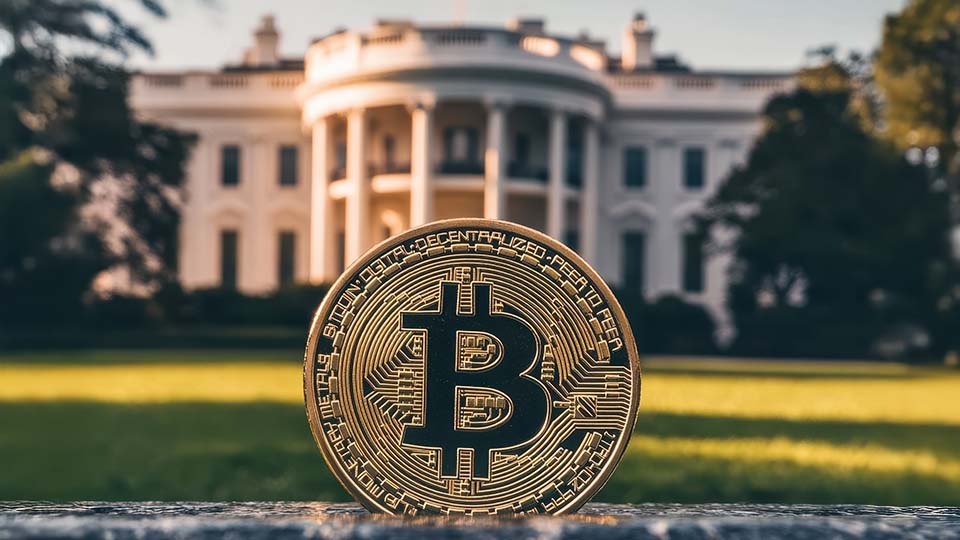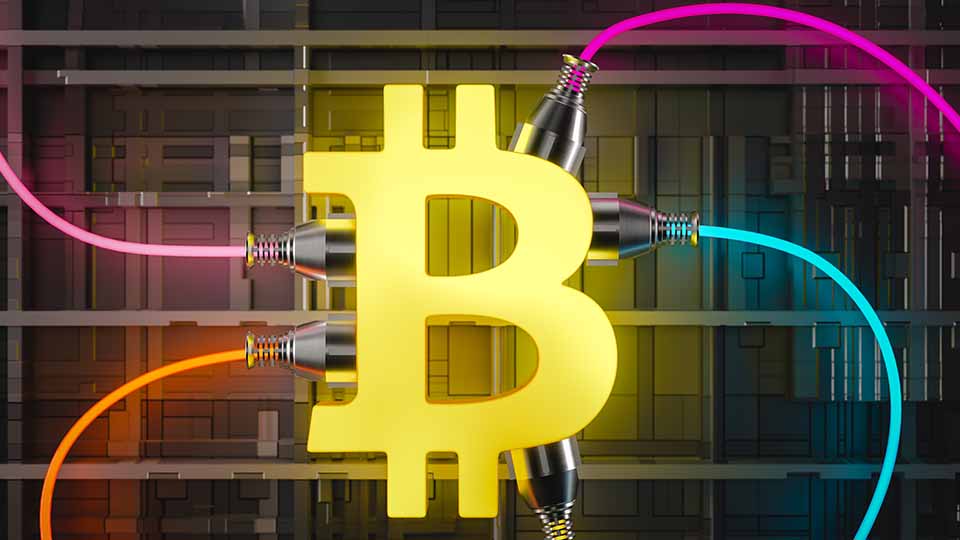VanEck Crypto Monthly Recap for March 2025
03 April 2025
Read Time 10+ MIN
Please note that VanEck may have a position(s) in the digital asset(s) described below.
March was a turbulent month, with 30-day average daily volatility surging to its highest level since August 2024: 72% for BTC, 95% for ETH, and 137% for SOL. The MarketVector™ Smart Contract Leaders Index (MVSCLE) fell (-11%) while BTC declined (-1%), outperforming the Nasdaq Composite Index (-8%) as investors grappled with tariff uncertainty, inflation concerns, and fiscal question marks.
Layer 1 Performance in March (-11%)
Source: MarketVectors of 3/31/2025. The MarketVector™ Smart Contract Leaders Index (MVSCLE) is designed to track the performance of the largest and most liquid smart contract assets. Index performance is not representative of strategy performance. It is not possible to invest directly in an index. Past performance is no guarantee of future results. Not intended as a recommendation to buy or sell any securities named herein.
Price Returns
| March (%) | 1-year (%) | |
| Bitcoin | -2 | 16 |
| S&P 500 Index | -6 | 7 |
| Nasdaq Index | -8 | 5 |
| MarketVector Smart Contract Leaders Index (MVSCLE) | -11 | -38 |
| MarketVector Meme Coin Index | -13 | -50 |
| MarketVector Infrastructure Application Leaders Index | -17 | -65 |
| Ethereum | -18 | -50 |
| Coinbase | -20 | -32 |
| MarketVector Global Digital Assets Equity Index | -21 | -14 |
| MarketVector Decentralized Finance Leaders Index | -22 | -64 |
Source: Bloomberg as of 3/31/2025. Index performance is not representative of fund performance. It is not possible to invest directly in an index. Past performance is no guarantee of future results. Not intended as a recommendation to buy or sell any securities named herein.
Offsetting the macroeconomic drag were several substantial crypto policy victories, including:
- Legislative/Executive
- White House establishment of a Strategic Bitcoin Reserve
- FDIC rescinded its prior approval requirement for crypto activity
- Stablecoin legislation (GENIUS Act) advanced in the U.S. House
- State legislatures are acting to establish BTC reserves and crypto rights
- U.S. Senate voted to repeal the IRS’s expanded crypto broker rule, easing DeFi reporting burdens
- US Treasury lifted sanctions on Tornado Cash
- Judicial
- SEC dropped the lawsuit against Ripple
- Criminal suits against HEX and Kraken were dismissed
- Galaxy Digital settled with the SEC
As is typical during macro-driven risk sell-offs, the 30-day correlation between BTC and NASDAQ rose from 0.19 on March 4 to 0.60 by March 28. Meanwhile, spot volumes collapsed to six-month lows of $1.34T, or $43B/day, down (-24%) from February 2025 and a (-55%) drop from highs in January 2025. Inflation came in lower than expected—2.8% vs. 3.0%—which helped soften the Fed’s tone in its March rate decision. Despite negative price action, U.S.-listed ETFs net purchased 246 BTC, while Saylor’s strategy acquired 29,000 BTC. New entrants to crypto treasury strategies included BioNexus (ETH) and GameStop (BTC), the latter having sold a $1.3B convertible bond with plans to allocate proceeds to Bitcoin.
Smart Contract Platform (SCP) Fundamentals Sag, Stablecoins in a Bull Market
Only 5 of the 34 major tokens we track ended March in the green among smart contract platforms (SCPs). The top performers were TON (+17%), MNT (+9%), and BNB (+1%). SCP fundamentals broadly sagged, with Revenues (-36%), DEX Volumes (-40%), and Stablecoin Transfer Volume (-5%) all down on the month—typical in an environment of declining risk appetite.
Yields tell the story: average returns on stablecoins have fallen sharply, now ranging from just above Treasury yields (4.9% 30-day average on Kamino/Solana) to significantly below (3.1% on Aave/Arbitrum). On Jan 1, 2025, those figures were 10% and 9%, respectively.
Yet even as yields fall, demand for stablecoins is growing. The total supply on-chain rose from $225B in February to $234B at month-end. Stablecoins are in a bull market of their own, with issuers ranging from VanEck and Trump’s Liberty Financial to Fidelity all launching or preparing new offerings. Earning yield on someone else’s idle capital remains a powerful business model.
March’s Notable Laggard – Solana (SOL) (-14%)
Solana loses DEX (Decentralized Exchange) Trading to Ethereum’s Ecosystem
Source: Artemis XYZ as of 3/31/2025. Past performance is no guarantee of future results. Not intended as a recommendation to buy or sell any securities named herein.
In March, Solana’s onchain activity declined sharply as speculative animal spirits retreated to the sidelines. Daily average fees dropped (-66%), Stablecoin Transfer Volume (-34%), and DEX Volumes plunged (-53%). After briefly overtaking Ethereum’s entire ecosystem in January, Solana’s share of smart contract platform (SCP) DEX volume fell to levels not seen since October 2024. The primary driver of this contraction was the collapse in memecoin trading. We estimate that daily memecoin volumes on Solana peaked at ~$12B in January during the height of the “season” but fell to ~$720M per day in March. Memecoins, excluding stablecoins and SOL, accounted for 92% of Solana’s remaining trading volume in March—highlighting their enormous impact on network revenues.
Memecoins Dominate Solan DEX (Decentralized Exchange) Trading
Source: Dune @ally as of 3/31/2025. Past performance is no guarantee of future results. Not intended as a recommendation to buy or sell any securities named herein.
Solana Keeps Inflation Levels
March also saw the debate over a proposal to reform Solana’s inflation model to make it more market-based. The current inflation rate is 4.6%, declining by ~15% annually on a predictable schedule. The proposed change—SIMD-0228—sought to lower inflation to ~1% and introduce a mechanism where inflation would rise and fall inversely with the percentage of SOL staked. This would mirror Ethereum’s model and incentivize what proponents called an “optimal” staking ratio.
SIMD-0228 aimed to reduce inflationary issuance and the resulting sell pressure, which we estimate could amount to $500M—$1B annually at March prices. However, critics warned that the change would render smaller validators uneconomical, potentially reducing the validator count from 1,312 to ~800. Others expressed concern that a variable inflation regime would hurt financial products like ETFs and undermine investor confidence due to increased unpredictability.
Ultimately, the Solana community voted down SIMD-0228. Inflation remains unchanged for now. Supporters of the proposal still argue for reform but acknowledge it should be paired with cost-reduction measures for validators. One promising suggestion is to eliminate transaction fees for consensus voting—a cost currently estimated at 1–2 SOL per day, disproportionately affecting smaller validators.
Solana Progresses Under New Regulatory Clarity
Despite declining on-chain activity, Solana achieved significant milestones off-chain. On March 18, the CME launched long-anticipated SOL futures contracts. Two days later, the first SOL futures ETF began trading. These developments pave the way for a spot SOL ETPs in the U.S.
The SEC, which will ultimately decide SOL's regulatory classification, may begin hearings on its non-security status as early as late spring or early summer.
March’s Notable Laggard – Ethereum (ETH) (-18%)
Layer 2 (L2s) DEX Volume Share Dips Amid Selloff, but Long-Term Trend Remains Intact
Source: Artemis as of 3.25.2025. Past performance is no guarantee of future results. Not intended as a recommendation to buy or sell any securities named herein.
Ethereum made meaningful technical progress in March as the long-awaited Pectra upgrade moved closer to deployment. Combining the Prague and Electra proposals, Pectra introduces several UX-enhancing features: transaction batching, ERC-20 fee payments, and sponsored transactions. These upgrades aim to streamline onboarding and reduce friction. For example:
- Transaction batching lets users combine multiple DeFi steps into one action.
- ERC-20 fee payments, and sponsored transactions allow users to pay gas without first acquiring ETH.
Pectra also enables native smart wallet functionality, including gasless transactions, one-click upgrades from EOAs (externally owned accounts) to programmable smart contract wallets, and single-step token approvals. Together, these changes significantly boost usability and security—key steps toward mainstream adoption.
After delays on earlier testnets, developers launched the "Hoodi" testnet on March 17. If testing goes smoothly, Pectra could activate on mainnet by late April.
Ethereum’s base-layer performance also improved modestly following a gas limit increase from ~30M to 36M in February—the first such change since the Merge in September 2022. With over 50% validator support, the new limit has helped ease congestion, with average gas fees dropping below 1 gwei during off-peak hours.
According to Glassnode, Ethereum’s 7-day average transaction fee has fallen to $0.41, down (-96%) from $9.23 year-over-year. Meanwhile, daily transactions have held steady at 1.19M, down just (-5.1%) from March 2024. Holding transaction counts constant, these improvements save users an estimated $11.1M daily.
Many developers now support further gas limit increases, which Vitalik Buterin argues is vital for censorship resistance and long-term scalability—especially in an L2-centric roadmap. Higher L1 throughput could also help Ethereum reclaim lost DEX share from L2s and bolster ETH’s yield, improving its inflation profile.
Despite technical momentum, Ethereum’s economic model remains under pressure. Standard Chartered cut its 2025 ETH price target in March from $10,000 to $4,000, citing structural issues with fee capture. L2s—especially Coinbase’s Base—are pulling value away from the L1. Base alone has diverted over $50B in market cap and substantial transaction fees.
This dynamic has prompted fears that Ethereum is "commoditizing itself" within its scaling architecture. Some in the community have floated ideas like L2 taxation to re-align incentives—where rollups would pay back to L1—but such proposals face steep political and technical hurdles. Enforcing them would require centralized intervention or protocol-level mandates, which clash with Ethereum’s ethos of neutrality, modularity, and permissionlessness.
Amid these growing pains, the Ethereum Foundation moved to strengthen internal leadership. In March, it appointed Hsiao-Wei Wang and Tomasz Stańczak as Co-Executive Directors, reaffirming its commitment to steward Ethereum's evolution—from a grassroots experiment to a censorship-resistant, modular base layer for global finance and software.
Layer 1 Updates
March Recap: MarketVector™ Smart Contract Leaders Index
Source: MarketVectors of 3/31/2025. The MarketVector™ Smart Contract Leaders Index (MVSCLE) is designed to track the performance of the largest and most liquid smart contract assets. Index performance is not representative of strategy performance. It is not possible to invest directly in an index. Past performance is no guarantee of future results. Not intended as a recommendation to buy or sell any securities named herein.
Tokenized Treasury Funds Break $5B as Regulation Pushes Yield Onchain
Source: rwa.xyz as of: 3.31.2025. Past performance is no guarantee of future results. Not intended as a recommendation to buy or sell any securities named herein.
In March, tokenized U.S. Treasury funds, a key segment of real-world assets (RWAs), surpassed $5B in total issuance, a (+26%) jump from February. This surge reflects an accelerating institutional adoption race fueled by blockchain’s efficiency and regulatory shifts favoring compliant yield options. Demand for safe, digital-native assets drives this growth as investors seek alternatives to low-yield stablecoins and volatile cryptocurrencies.
Joining this trend, Fidelity Investments filed with the U.S. Securities and Exchange Commission to introduce an ‘Onchain’ share class for its Fidelity Treasury Digital Fund (FYHXX). This fully regulated money market fund leverages a public blockchain to mirror share ownership and transaction history. Unlike leading issuers such as Franklin Templeton, BlackRock, and Ondo Finance, whose funds are typically fully tokenized and settled natively across multiple blockchains, Fidelity’s conservative approach uses the blockchain as a secondary ledger: official recordkeeping remains with its traditional transfer agent, offering a regulatory-first model to broaden institutional adoption without replacing existing structures.
This month’s surge in tokenized treasury funds also coincided with key U.S. legislative developments. In late March, the House released the STABLE Act, which explicitly prohibits yield-bearing payment stablecoins, i.e., dollar-pegged digital assets offering interest or returns from their underlying collateral. The GENIUS Act advanced earlier in Congress, takes a similar stance: its latest version, passed by the Senate Banking Committee in March 2025, defines ‘payment stablecoins’ to exclude yield-bearing variants. This marks a shift from earlier drafts’ light-touch approach, which appeared more permissive and all-encompassing, now deliberately tightened in scope.
By clearly separating ‘digital cash’ from yield-generating assets, both acts may unintentionally bolster the value proposition of tokenized treasury funds by positioning them as the compliant, modular pathway for onchain exposure to government debt yields. Both the STABLE Act and the GENIUS Act permit banks and non-bank entities to issue stablecoins, fostering a private-sector alternative to CBDC risks while expanding the tokenized treasury fund space’s compliant issuers.
Links to third party websites are provided as a convenience and the inclusion of such links does not imply any endorsement, approval, investigation, verification or monitoring by us of any content or information contained within or accessible from the linked sites. By clicking on the link to a non-VanEck webpage, you acknowledge that you are entering a third-party website subject to its own terms and conditions. VanEck disclaims responsibility for content, legality of access or suitability of the third-party websites.




